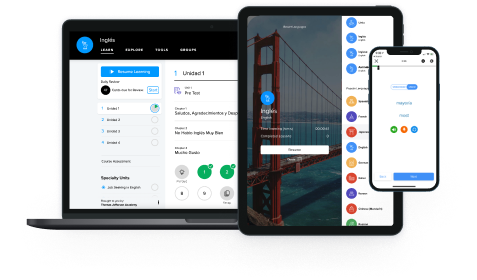Note that the ending for wir(we) and sie(they) are the same as the infinitive, and er, sie, es(he, she, it) and ihr(you, pl.) are identical as well, so that’s only four endings to memorize.

The present tense (Präsens) in German is used in many different situations: stating general facts, talking about actions going on right now, and even talking about future plans. Luckily, it’s also not too difficult to form, just delete the infinitive ending and add the agreement endings!
“The present is a gift” as they say and this is true for the present tense as well. Have you already come across the sentence Ich heiße…(My name is...) or Wie geht es dir?(How are you?) Perfect! You already know a little bit about the present tense.
In this post, we’ll cover how to form the present tense in German, and then go through some of the situations you should describe using this tense. Ready to have a look? Let’s dive in!
How to form the present tense in German?
In German, the present tense of verbs is formed by removing the infinitive ending and adding present tense endings. Let’s look at an example of how this works!
We start with the infinitive of a regular verb: spielen(to play)
We delete the ending -en, we are left with the of the verb: spiel-
To this stem we add the agreement endings -e, -st, -t, -en, -t and -en. The ending you choose depends on the subject
Pronoun | Ending | spielen(to play) |
|---|---|---|
ich I | -e | spiele |
du you | -st | spielst |
er, sie, es he, she, it | -t | spielt |
ich we | -en | spielen |
ihr you, pl. | -t | spielt |
sie they | -en | spielen |
Tip
A few tiny exceptions:
If the stem of the verb ends in d or t, add an e before the -st and -t endings. This is also necessary for some verbs whose stem ends in m or n.
baden(to bathe):
✅du badest ❌badst
✅er badet ❌badt
However, in verbs with changes (see below), do not worry about an additional e:
raten(to guess):
✅du rätst ❌ratest
If the stem ends in s, ß, x or z, remove the s in the du-form.
pflanzen(to plant):
✅du pflanzt ❌pflanzst
If the infinitive form ends in -eln or -ern, remove the e in the first and third-person plural:
plündern(to plunder):
✅wir plündern ✅sie plündern ❌plünderen
In addition to those little exceptions, some verbs are or have a vowel in the stem that changes before you add the ending. Let’s look closer at these cases!
What are the vowel changes in the German present tense?
When the first vowel of a German verb is e or a, that stem vowel often changes slightly in two forms of the present tense:
the du(you sg.) form
the er, sie, es(he, she, it) form
Verbs that undergo this sort of stem vowel change will still take the regular verb endings we saw above. Let’s look at some examples:
e becomes i:
sprechen(to speak)Ich spreche Deutsch
I speak German
Sprichst du Deutsch?
Do you speak German?
Er spricht Deutsch.
He speaks German.
e becomes ie:
lesen(to read)Wir lesen Zeitung.
We are reading the newspaper.
Liest du Zeitung?
Are you reading the newspaper?
Sie liest Zeitung.
She is reading the newspaper.
a becomes ä:
halten(to hold)Ich halte die Tasche.
I am holding the bag.
Hältst du die Tasche?
Are you holding the bag?
Er hält die Tasche.
He is holding the bag.
Important
Note that not all verbs with these stem vowels undergo these vowel changes! For example:
stehen(to stand):
✅du stehst ❌du stihst
sagen(to say):
✅du sagst ❌du sägst
Which verbs are irregular in the present tense in German?
A few German verbs are more irregular in the present tense. The most important two are sein(to be) and haben(to have), which are used so often, you will memorize them in no time.
Pronouns | sein(to be) | haben(to have) |
|---|---|---|
ich I | bin | habe |
du you | bist | hast |
er, sie, es he, she, it | ist | hat |
ich we | sind | haben |
ihr you, pl. | seid | habt |
sie they | sind | haben |
Some examples of sentences with these forms:
Hi, ich bin Claudia. Hast du eine Minute für mich?
Hi, I am Claudia. Do you have a minute for me?
Das ist Tim. Er hat eine Katze.
This is Tim. He has a cat.
The German modal verbs are also quite common and are somewhat irregular. For the forms of other irregular verbs, check out our list of irregular present tense verbs in German.
What are the word order rules for the German present tense?
The German present tense follows the standard German word order rules:
In simple sentence, the verb comes second:
subjectpresent tenseIch spiele mit meinem Bruder.
I play with my brother.
Form questions by bringing the verb to the front followed by the subject:
subjectpresent tenseSpielst du…?
Do you play…?
Form a negative sentence with nicht:
negationpresent tenseIch spiele nicht.
I do not play.
When to use the present tense in German?
In German the present tense has a lot more uses than the English simple present. We use this tense to discuss:
general facts and habits
actions happening “right now”
actions that have been happening for some amount of time or since some time
planned or certain future events
the past (when being dramatic)
Let’s look at some examples of each of these uses!
General facts and habits
Like in English, we can use the present tense to state facts:
Die Erde ist rund.
The earth is round.
Also, the present tense comes in handy for describing habits or other actions which occur regularly, such as:
Ich besuche meine Oma jede Woche.
I visit my grandma every week.
Even when you want to say that you never do something, the present is your tense:
Ich gehe nie ins Schwimmbad.
I never go to the swimming-pool.
Important
You can also talk about things someone never did in the past by using with nie(never) + past tense:
Ich habe noch nie Volleyball gespielt.
I have never played volleyball before.
Actions happening “right now”
In German, we use the present tense to talk about things that are happening “right now” (or during the moment of speech).
Ich lese gerade einen Blogeintrag.
I am reading a blog post at the moment.
When translating this use of the German present tense into English, you’ll usually use the present progressive (“is verbing”), but in German we use the regular simple present tense.
Important
As you see, there is no special ending for the progressive (such as “-ing”) in German. Grammatically, there is no difference between actions happening right now and actions happening regularly, you’ll just need to look at context:
Vicky spielt jetzt Fußball.
Vicky is playing soccer now.
lit. Vicky plays soccer now.
Vicky spielt jeden Freitag Fußball.
Vicky plays soccer every Friday.
In German, it is the words jetzt(now) and jeden Freitag(every Friday) that determine the time of the action.
For actions that have been happening “for” or “since” some time
In German, we use the present tense for actions or situations that have been happening for some amount of time or which have been happening since some past moment.
Wir gehenseit zwei Jahren zusammen zur Schule.
We’ve been going to school together for two years.
lit. We go to school together for two years.
Planned or certain future events
In German, we use the present tense to talk about planned or certain future events, much like you might in English. The context will usually make it clear that you’re talking about the future and not the present.
Sie fahren nächsten Sommer nach Italien.
They are going to Italy next summer.
lit. We go to Italy next summer.
Check out our post on expressing the future in German to learn more about how this compares to the other ways we can talk about future events!
To make the past sound more dramatic
Yes, you’ve read this correctly. Sometimes the German present tense is even used to tell a story which took place in the past! Usually, this happens in spoken language when people tell an anecdote or a funny thing from not too long ago.
Letzten Samstag, ich geh’ wie immer im Wald spazieren und wen treff’ ich an der Bank? Meinen Onkel Hubert!
Last saturday I’m going for a walk in the forest as always, and who do I meet at the bench? My uncle Hubert!
TipSound like a native:
Did you notice that in the example above, gehe and treffe are shortened to geh’ and treff’ in the first person? This is often done in spoken language, but in formal situations, remember to always spell out the full form.
Summary
Let’s take a quick look at what we’ve covered today:
When forming the German present tense, there are…
regular verbs → just add an ending to the stem.
stem-changing verbs → a stem vowel changes (e can become i or ie and a becomes ä), but we use the regular verb endings.
irregular verbs → must be memorized, as with sein(to be) and haben(to have).
The present tense can be used for many different situations:
general facts and regularly occurring actions
actions happening right now
actions that have been happening for some time
future events that are certain
narrations of past events
Ready to practice? Check out our German present tense exercises! Or, if you’d rather study, open up our chart of irregular present tense verbs!
